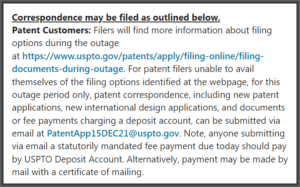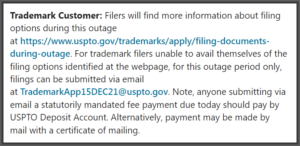Here is a bit of an update at about 7AM from an external observer on the massive system crash at the USPTO. The following systems are unresponsive:
- Patentcenter
- EFS-Web
- EFS-Web contingency
- Private PAIR
- TEAS
Probably other systems are unresponsive as well. Those are the ones that I checked.
As a reminder if the type of patent application that you want to file is a PCT application, you are going to want to figure out whether you can use RO/IB instead of RO/US. See this blog post for more about this.
The USPTO web site provides fallback paths for e-filing patent applications and trademark applications. Each of the two paths involves sending email to the USPTO. Each of the two paths is coded wrong in terms of the HTML. This blog posting tells you what’s wrong in the HTML coding and how to get the paths to work.
The email path for patent e-filing. Here is how it looks to the eye in the USPTO’s web page telling you the email path for patent e-filing:

The email address displayed is “PatentApp15DEC21@uspto.gov” and it appears in the color that the USPTO uses for clickable links. Here is the HTML source for that part of the web page:
<a href=”https://PatentApp15DEC21@uspto.gov/” target=”_blank” style=”background-color: rgb(255, 255, 255);”>PatentApp15DEC21@uspto.gov</a>.
Those who know HTML immediately see the mistake. The thing that appears before the colon is called the “protocol” and the protocol that the USPTO person specified was “http”. The USPTO person should have specified “mailto”. Had the HTML coding been done correctly, clicking on the link would launch the reader’s email client with the start of an email message to that email address. Instead, clicking on the link tries to go to a web page that does not exist.
The trailing slash was also incorrect for that protocol and the attributes “target” and “style” should not have been used. The correct HTML code is:
<a href=”mailto:PatentApp15DEC21@uspto.gov”>PatentApp15DEC21@uspto.gov</a> .
It would also have been better to put a space after the link (as you see here) so that if a reader were to try to copy and paste the email address, the reader would be less likely to inadvertently copy the period with it.
The email path for trademark e-filing. Here is how it looks to the eye in the USPTO’s web page telling you the email path for trademark e-filing:

One oddity about this paragraph is its bold-faced lead “Trademark Customer:” which is missing the plural “s” after “Customer”. Yes I realize the damage control people at the USPTO must have been in a big rush at 7PM Eastern Time yesterday when everything crashed. This web page got posted at about 8:30 PM Eastern Time yesterday and yes I am sure that the hour and a half between when the crash happened and when this page got posted must have been a frantic time. But since then, eleven hours have come and gone. Plenty of time has passed during which somebody could have fixed the HTML coding mistakes described in this blog message. And then while they were at it, the person fixing the HTML coding mistakes could have provided the missing “s” in “Customers”.
Okay back to the HTML coding mistake. The email address displayed is “TrademarkApp15DEC21@uspto.gov” and it appears in the color that the USPTO uses for clickable links. Here is the HTML source for that part of the web page:
<a href=”https://TrademarkApp15DEC21@uspto.gov/” target=”_blank”>TrademarkApp15DEC21@uspto.gov</a>.
Once again what jumps off the screen for anybody who has ever done even the simplest HTML work is that the protocol “mailto” should have been used, not “http”. (Oh, and by the way, if a link to a web page had been intended, which it was not, these days the correct protocol would have been “https”, not “http”.) Oddly, the person making the mistake did not this time include the spurious “style” attribute that was incorrectly included in the link for the patent path.
The correct HTML code is:
<a href=”mailto:TrademarkApp15DEC21@uspto.gov”>TrademarkApp15DEC21@uspto.gov</a> .
Tips for use of the two email links. A first thing to know is that email addressing is not case sensitive. Do not worry about the weird capitalization that the USPTO person used here. It is not actually necessary for the “A” to be uppercase or for the “DEC” to be uppercase.
A second thing to keep in mind is how to pay the government fees. The writer of the web page seems to be obliquely trying to say “don’t include Form 2038 in your email”. Why, I don’t know, except I suppose the rush-rush workflow that they have cobbled together for handling the emails probably assumes a sort of nearly mindless loading of the email pages into IFW. And we already know they recommend (correctly) that filers not e-file Form 2038 in a way that is likely to get into IFW since it might become publicly viewable instantly or later. So the only payment mechanism that is sort of half-way usable for emailed filings is the deposit account. Fortunately you don’t need to pay any fees at all to get a filing date for a domestic US patent application.
You do, though, have to pay at least the base national filing fee if the thing you are trying to do is stave off abandonment at the end of the 30 months for a PCT US national-phase entry. So you might need to use your Deposit Account for that. And of course you do have to pay for at least one trademark class to get a trademark application filing date. So you might need to use your Deposit Account for that.
They don’t say it on the web site, but I imagine if you are desperate and either don’t have a Deposit Account or have depleted it already during this massive outage, you might consider doing a hybrid filing. Send in part of the filing by email and part of the filing (the Form 2038) by fax to the Central Fax Number (which is 571-273-8300). Of course you would have to somehow think of an unambiguous way that frazzled USPTO personnel could later marry the two submissions together. For any case for which you do not yet know the application number that you are about to receive, this is probably not possible. But for a US national phase entry, I can imagine that the international application number might work as a linking clue for the frazzled USPTO personnel. And of course for follow-on submissions, the application number itself might work as a linking clue.
The remaining thing to worry about is the date that is embedded in the email address. It is a “15” but part of the outage, from midnight Eastern Time until around 6AM on the 16th, was not on the 15th. I wonder whether the USPTO is going to try to match the date of a filing with the date embedded in the email message.
